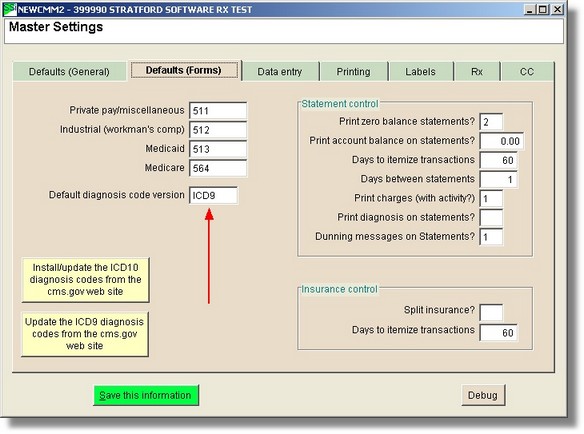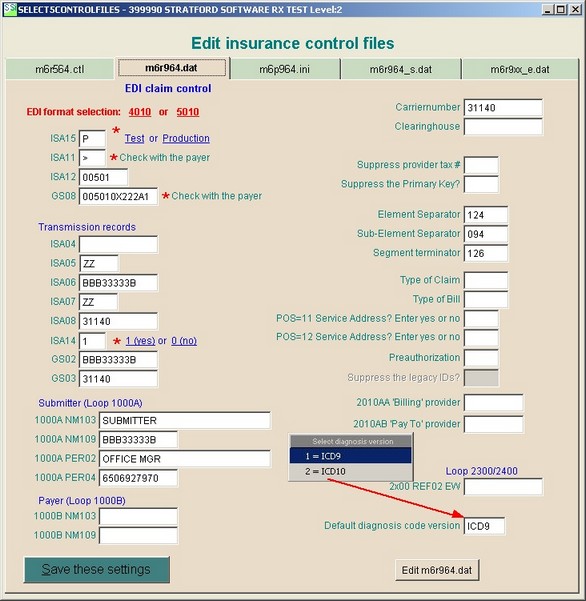According to the HIPAA timeline at the time this was written, the ICD-10 codes may be used before the October 1, 2014 deadline - After ANSI X.12 v5010 is accepted. During this time we expect some payers to test/accept the ICD-10 codes while others will still require ICD-9. We have made changes to the software to accommodate this. You may continue to use the ICD-9 codes while you are doing data-entry and have the software do a lookup and find the closest ICD-10 match for your claim transmission. In fact, you may use a mixture of ICD-9 and ICD-10 codes and the software will transmit all ICD-10 codes for those payers that you set up to accept ICD-10 codes.
The way you do this is leave your 'main control variables' set to ICD-9. You may or may not install the ICD-10 codes as it will not affect the software operation. We suggest that you do not install the ICD-10 codes until you want to start using them. Remember that some payers may not accept the ICD-10cm diagnosis codes until the October, 2014 deadline.

From the main directory select #8, #7, #3, Enter the form code (ex: 564, 964, 5gateway, 9gateway)
On the "Edit insurance control files" screen for the specific form code that you want to transmit ICD-10 codes, select the 2nd tab labeled m6r9xx.dat (where xx is assigned by you: ex: m6r964.dat or m6r9gateway.dat). In the lower right see the text box labeled 'Default diagnosis code version'. Enter ICD10 in this text box (do not enter a dash).

If you right click on the text box you can select from the shortcut menu either ICD9 or ICD10.
This will result in a 'ICD-10 lookup' when the claim for this form code is created and transmitted. Your ICD-9 codes will be converted to the closest match in the ICD-10 listing. If you have ICD-10 codes in your database, they will not be changed.
Note: the software allows you to continue entering ICD-9 codes during the time prior to the October, 2014 deadline. At the same time, you could send ICD-10 codes to Payer A, ICD-9 codes to Payer B, ICD-10 codes to Clearinghouse C. You can begin using ICD-10 codes without having them in your local database. This should make it easy for you to begin using ICD-10 codes many months prior to the deadline so you can get familiar with them. The ICD-10 codes are completely different from ICD-9 codes and it will probably take a significant amount of time for you to learn to use them. We recommend that you begin testing as soon as any payer allows it. When your transmission is accepted, begin 'production' transmitting with ICD-10 codes immediately, even if you have not started entering them in your database. With the Stratford program you can turn it on, then off and back on as needed. We are ready to help you and we appreciate your feedback.
Note: the reverse of the text above is also true. If you enter some ICD-10 codes and also some ICD-9 codes in your database, they will be converted as needed to comply with what you want for each transmission receiver (form code: payer, clearinghouse). The conversion is a 'best match' conversion. It probably will not be perfect and will not substitute for using the best, correct diagnosis code.
We plan to offer a utility to convert all of your existing ICD-9cm diagnosis codes to ICD-10cm codes sometime prior to the October, 2014 deadline. You should not use this utility until you are certain that all your payers will accept the ICD-10 codes. Note that this conversion will convert to the nearest acceptable ICD-10cm codes but will not be a substitute for using the best ICD-10cm code. As you probably know by now, there are many thousands more ICD-10 codes than ICD-9 codes. This will allow you to do a better job of describing the patient condition. Payers will require you to do this.